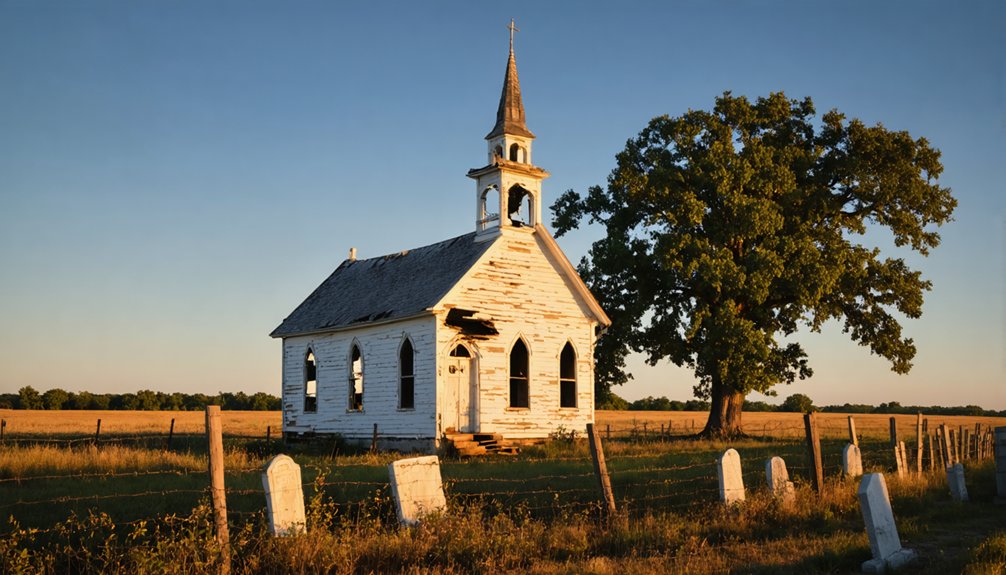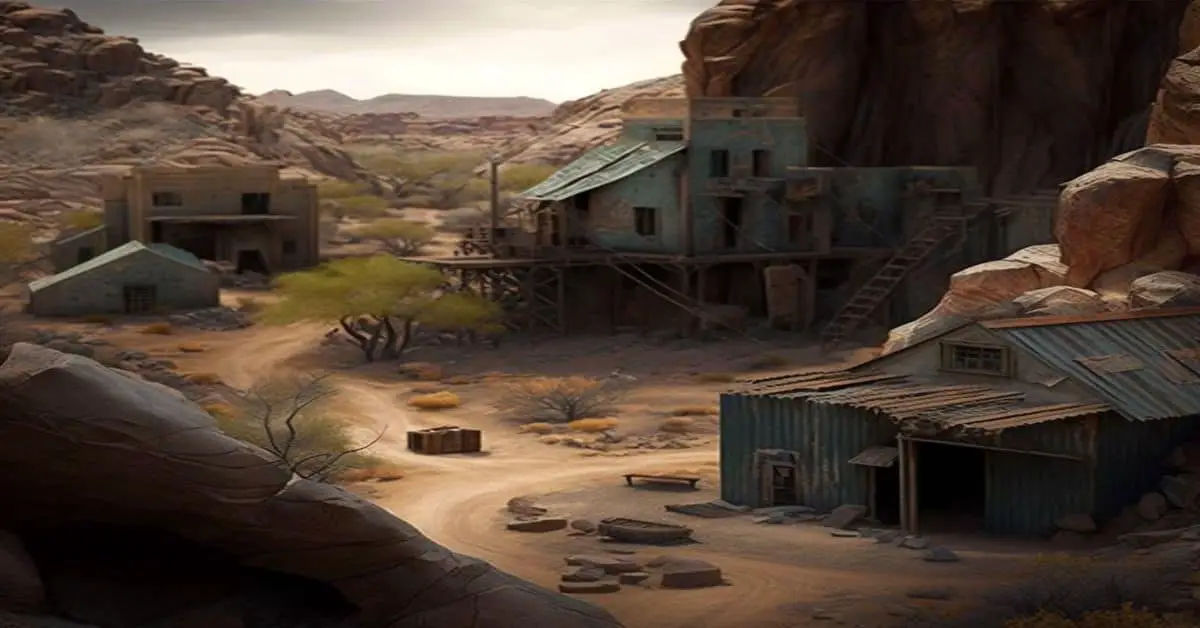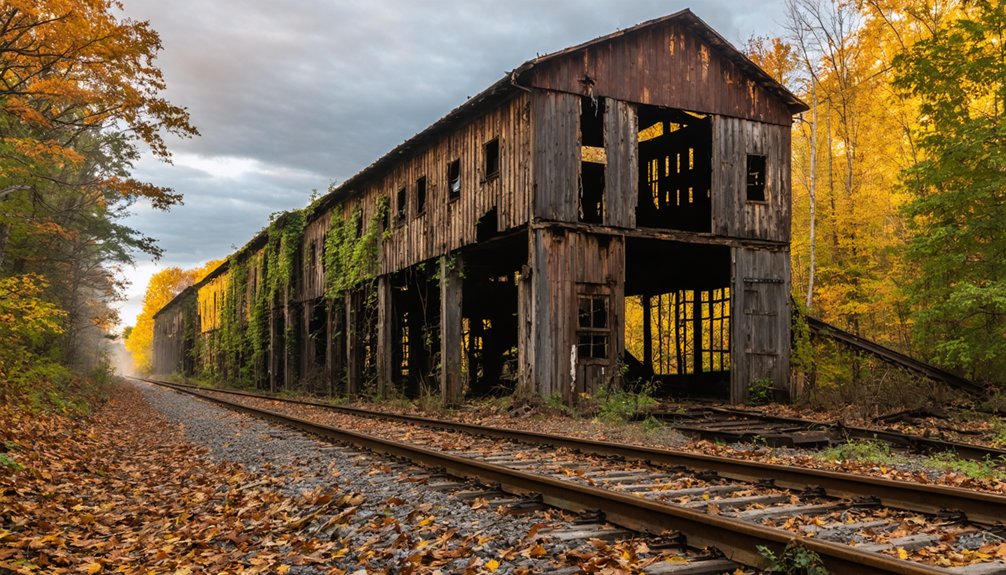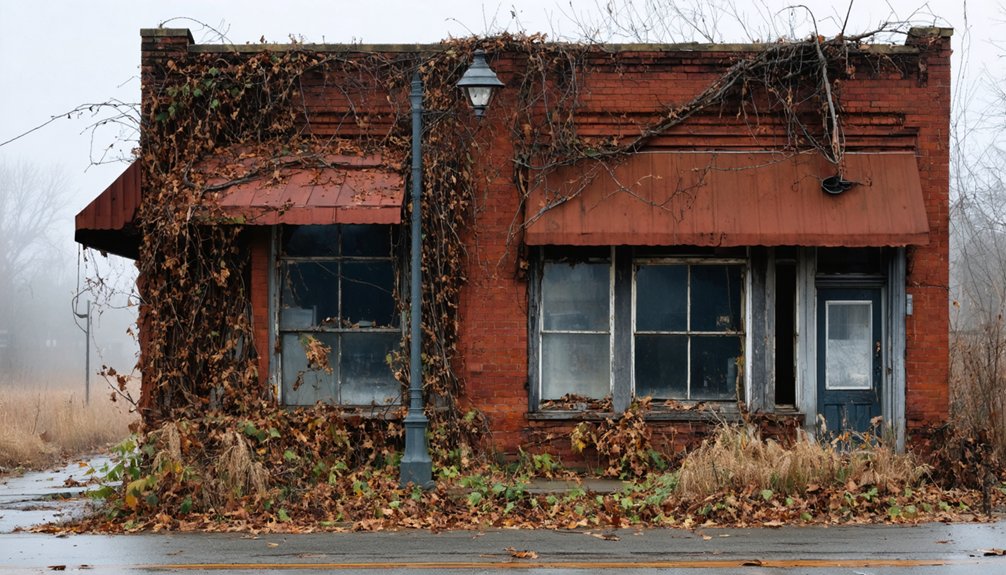You’ll find Warrenton at the confluence of Big Pine Creek and the Wabash River, where it briefly served as Warren County’s first seat in 1827. The town’s seven-block layout included a central square and log courthouse, but its reign lasted barely a year before Williamsport took over in 1828. Today, this ghost town‘s footprint can be traced through historical maps and local records, offering fascinating glimpses into early Indiana settlement patterns and political shifts that shaped the region.
Key Takeaways
- Warrenton was Warren County’s first seat established in 1827 at the confluence of Big Pine Creek and Wabash River.
- The town lost its county seat status to Williamsport in 1828 due to financial incentives and political maneuvering.
- Originally designed with seven blocks and a central square, Warrenton’s population declined after losing administrative importance.
- Historical records from 1827-1854, including marriage, land, and court documents, preserve evidence of the ghost town’s existence.
- Modern mapping technology and historical cartography help locate Warrenton’s exact position within present-day Warren Township.
The Birth of Warren County’s First Seat
The birth of Warrenton as Warren County’s first seat unfolded shortly after Indiana’s legislature established the county on March 1, 1827. In a region previously inhabited by Miami, Kickapoo, and Potawatomi peoples, you’ll find that Warrenton’s selection came at a pivotal time of frontier expansion.
Following a public land auction in March 1828, officials chose this strategic location above the confluence of Big Pine Creek and the Wabash River. The town’s design reflected the era’s pioneering spirit, featuring seven blocks of eight lots each and a central public square. The area’s development was aided by fur trading commerce that had flourished under early settlers.
You’ll appreciate how they established a simple log courthouse as the county’s first administrative center, marking Warrenton’s brief but significant role in local governance. This historic selection built upon the area’s trading legacy, established earlier by French trader Zachariah Cicott. The town’s prominence was short-lived, as Williamsport became county seat due to stronger financial backing from its residents.
From Administrative Hub to Abandonment
Although Warrenton initially held promise as Warren County’s administrative center, its tenure as county seat lasted barely a year before Williamsport claimed the title in 1828.
You’ll find that Williamsport’s reported “donations” to county officials played a decisive role in this change, forever altering the region’s community dynamics.
The historical significance of this administrative shift proved devastating for Warrenton’s future.
Despite its strategic location near the Illinois border and the confluence of Big Pine Creek and the Wabash River, you’d soon see the town’s influence wane.
With the county’s sparse population of just 8,500 spread across 365 square miles, Warrenton couldn’t sustain itself once Williamsport began attracting infrastructure investments and civic developments.
The 1907 courthouse construction in Williamsport marked the final seal on Warrenton’s fate.
Mapping the Lost Township
Modern mapping technology has revolutionized our ability to pinpoint Warrenton’s exact location within Warren Township’s 36.4-square-mile expanse.
You’ll find this ghost town exploration simplified through interactive tools that overlay historical cartography onto current satellite imagery, letting you zero in on the southwestern corner where Warrenton once stood.
Using online PLSS mapping systems, you can trace the township’s boundaries along U.S. Route 41 and State Road 55, while following the natural contours of local waterways like Kickapoo Creek and the Wabash River. The disambiguation pages help researchers distinguish this Warren Township from others with the same name across different states.
PLSS digital mapping tools reveal Warren Township’s borders by tracking major highways and meandering waterways that shaped this historic region.
Though no physical structures remain, you’re able to identify the ghost town’s footprint by cross-referencing historical plat maps with modern GIS data through platforms like IndianaMap, revealing precisely where this former county seat once thrived. The Public Land Survey System provides essential grid references for accurately locating historical sites within the township.
Legacy in Local Records
Detailed records from Warrenton’s brief reign as Warren County’s first seat of government still exist today, offering valuable insights into early pioneer life in Indiana.
Though this ghost town’s physical presence has vanished, its historical significance lives on through carefully preserved documentation.
- Marriage records starting from 1827 reveal early settler family connections and community bonds.
- Land records from 1826 trace property ownership and development patterns around Big Pine Creek.
- Court records beginning in 1827 document legal proceedings and daily life during Warrenton’s peak.
- Microfilmed newspapers from 1854 onward chronicle the town’s gradual decline.
Similar to the well-preserved Eliza Furnace in Vintondale, these historical remnants offer a window into early industrial America.
You’ll find these records at the Warren County Clerk’s office in Williamsport, where they’ve survived despite the 1907 courthouse fire.
The Warren County Historical Records Database provides digital access to these invaluable pieces of Indiana’s frontier heritage.
Preserving Warrenton’s Memory
Despite Warrenton’s physical decline, dedicated preservation organizations work tirelessly to protect and promote the ghost town’s rich heritage.
Through community engagement initiatives like historic home tours and Partners’ Events, you’ll discover how local groups maintain the town’s legacy for future generations.
The Paint Assistance Program and partnership opportunities allow you to directly contribute to historic preservation efforts, whether you’re a business owner or volunteer.
You’ll find informative materials and signage throughout the area detailing original homeowners and significant dates, while archaeological surveys document both Euro-American and Native American sites.
Walking down the streets, you’ll notice each historic residence features detailed markers indicating its name and construction year.
Indiana’s Cultural Resources Management Plan supports these educational outreach efforts, ensuring that Warrenton’s unique architectural and cultural heritage remains accessible even as its physical presence fades into history.
Since 1997, the area’s preservation movement has been guided by the powerful motto “PRESERVING THE PAST FOR THE FUTURE” to protect historically significant sites.
Frequently Asked Questions
What Natural Disasters, if Any, Contributed to Warrenton’s Decline?
You won’t find any evidence of flood damage or natural disasters causing Warrenton’s decline. Instead, economic decline driven by losing county seat status to Williamsport in 1829 sealed the town’s fate.
Did Any Famous Pioneers or Historical Figures Settle in Warrenton?
You won’t find any nationally renowned pioneers here – just local contributors like surveyor Perrin Kent, mapmaker Luther Tillotson, and landowner Hollingsworth, who helped establish this modest administrative center.
What Businesses and Industries Operated in Warrenton During Its Peak?
You’d find government offices and small merchants serving local needs, but Warrenton’s lack of strong railroad connections limited its local economy to basic services and nearby agricultural trade.
Are There Any Surviving Photographs of Warrenton From Its Active Period?
Despite searching through over 1,000 Indiana historic archives, you won’t find any surviving photographs of the town’s active period. The lack of photographic evidence leaves its visual history a mystery.
What Happened to the Original County Records When Warrenton Was Abandoned?
You’ll find most records were likely transferred to Williamsport when it became the new county seat, though record preservation challenges make it tough to confirm every document’s fate with complete certainty.
References
- https://kids.kiddle.co/Warrenton
- https://indianacountyparks.org/our-trails/ghost-town-trail/ghost-town-trail-history/
- https://www.youtube.com/watch?v=YENGw3D73t4
- http://freepages.rootsweb.com/~gtusa/history/usa/in.htm
- http://ingenweb.org/intippecanoe/ghosttowns.htm
- https://en.wikipedia.org/wiki/Warrenton
- https://storymaps.arcgis.com/stories/9a3b3f4a63ba4031a46cb53907a0515c
- https://en.wikipedia.org/wiki/List_of_ghost_towns_in_Indiana
- https://www.onlyinyourstate.com/experiences/indiana/ghost-towns-in
- https://kids.kiddle.co/Warren_County



